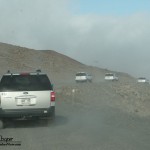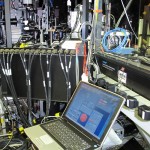Tuesday, April 27th was an exercise in chaos.

At Hale Pohaku we were met by a film crew. Documentary film crews are an occupational hazard at Keck. I have appeared in more than one show. Not usually a problem, this day the crew would be yet one more complication.
For myself, things started to go bad with an email message, trouble with a key piece of equipment in AO. At the heart of the adaptive optics system is a thin flexible mirror that can change shape to correct the light, the DM or deformable mirror. In order to monitor this mirror a WYKO interferometer is used to image its surface. This device shines laser light at the mirror, the return light is interfered with itself, allowing the surface shape to be analyzed with incredible accuracy. This is used to calibrate the AO system at the beginning of each night. Gone was my plan of a simple day doing some documentation checks to prepare for some upcoming modifications to the system.
The image provided by this interferometer was fading, the AO staff attempting to use the system could not get a good view of the DM and could not make any measurements. Of course this piece of equipment is easy to get to and work on… not! It is under the AO bench, requiring crawling over a pile of cables under the AO bench. Being a clean area, entering AO also requires dressing up in a Tyvek coverall, bonnet and booties. We were in and out of AO many times, meaning each time we would have to stop and pull on the clean room garb and to take it off again when exiting.
After a number of checks the verdict was clear, the laser inside the interferometer was dying. We did make adjustments to brighten the image so it could be seen, but the laser was becoming unstable as it dies, making measurements unreliable. With the brighter image the operators can at least muddle through, hopefully long enough to get replacement parts and arrange a time that we can take the system offline for repair. That will take numerous phone calls to vendors, requisitions, planning meetings and an attack plan. With the AO system in almost continual use everyone is affected.
Just before lunch the next tour arrived, a group of seniors from a local high school. A large contingent of students from Kealakehe HS, yet another addition to the increasing confusion of the day.
It was when I attempted to eat a late lunch that I ran into more trouble. After warming my lunch in a break room crowded with students I found only one seat at a table available. Also at the table was a high school student with her head down. When I looked to her chaperone I got the answer “she is just tired”. Sensing something was wrong I tried to rouse the student, and got nothing but a mumble. She was not resting her head, she was close to unconscious. A few moments later we had her on full oxygen, and a few minutes later she and another student also suffering some less serious altitude sickness were on their way down the mountain to meet an ambulance. Fortunately the medical attention was merely a safety precaution, both students were quickly checked and released by the hospital, back to normal once they returned to lower altitude and full atmospheric pressure.
The events remind us of what those of us who work daily at the summit sometimes forget, high altitude can be serious. There is 40% less pressure and less oxygen available to the body.

The film crew had also returned, setting up several cameras to film the sunset, the opening of the domes. Another camera was set up to do a time lapse sequence into the night, a camera which would be in place through much of the night taking photos of the stars wheeling overhead punctuated by a laser working science targets.
As part of the AO operations team I had volunteered to stay into the night and help guide the evening tour. Enough staff on hand to insure everyone was safe and we didn’t have any repeats of the incidents that had occurred with the students earlier in the day. Several of our guests carried good cameras and knew how to use them. While the laser was operating we walked up the access road a way to where we cold get a few nice photos of the beam. I have done this before and was able to pass along a few hints, several people managed very nice photos of the Keck 2 telescope and laser against the stars.
Through it all I was surprised how well our staff handled everything. The repeated surprises and events were simply taken in stride, each crisis dealt with and successfully resolved. A result of planning and skill put together. We regularly talk about how to handle problems, what the procedures are. That came together and we made it through a chaotic day with everything intact. When darkness fell both telescopes were open and on-sky.

